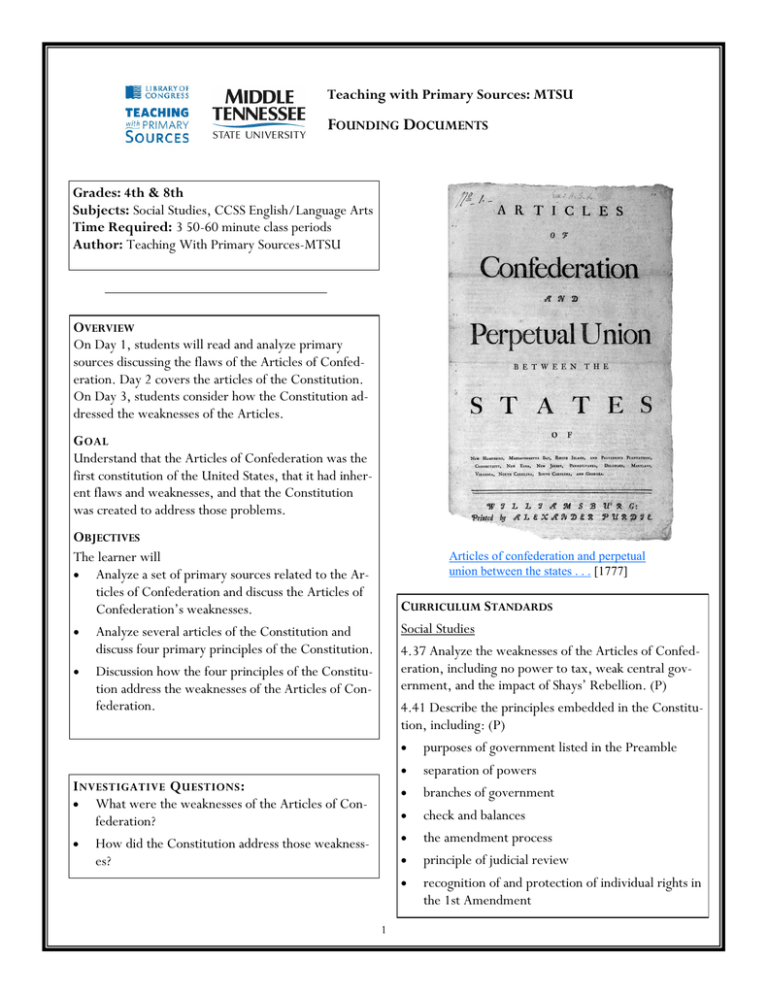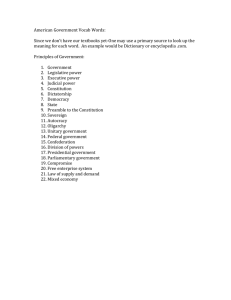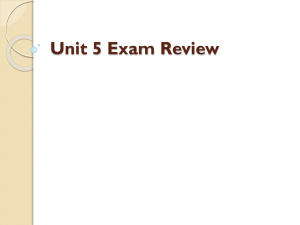F D
advertisement

Teaching with Primary Sources: MTSU FOUNDING DOCUMENTS Grades: 4th & 8th Subjects: Social Studies, CCSS English/Language Arts Time Required: 3 50-60 minute class periods Author: Teaching With Primary Sources-MTSU OVERVIEW On Day 1, students will read and analyze primary sources discussing the flaws of the Articles of Confederation. Day 2 covers the articles of the Constitution. On Day 3, students consider how the Constitution addressed the weaknesses of the Articles. G OAL Understand that the Articles of Confederation was the first constitution of the United States, that it had inherent flaws and weaknesses, and that the Constitution was created to address those problems. OBJECTIVES The learner will Analyze a set of primary sources related to the Articles of Confederation and discuss the Articles of Confederation’s weaknesses. Analyze several articles of the Constitution and discuss four primary principles of the Constitution. Discussion how the four principles of the Constitution address the weaknesses of the Articles of Confederation. Articles of confederation and perpetual union between the states . . . [1777] CURRICULUM STANDARDS Social Studies 4.37 Analyze the weaknesses of the Articles of Confederation, including no power to tax, weak central government, and the impact of Shays’ Rebellion. (P) 4.41 Describe the principles embedded in the Constitution, including: (P) purposes of government listed in the Preamble separation of powers branches of government check and balances the amendment process principle of judicial review recognition of and protection of individual rights in the 1st Amendment I NVESTIGATIVE Q UESTIONS : What were the weaknesses of the Articles of Confederation? How did the Constitution address those weaknesses? 1 CURRICULUM STANDARDS (CONT.) 8.30 Analyze the weaknesses of the Articles of Confederation, including no power to tax, no common currency, no control of interstate commerce, and no executive branch , failure of the Lost State of Franklin and the impact of Shays’ Rebellion. (C,E, H, P, TN) 8.33 Describe the principles embedded in the Constitution, including the purposes of government listed in the Preamble, separation of powers, check and balances, the amendment process, federalism, and recognition of and protections of individual rights in the Bill of Rights. Common Core Standards: English Language Arts Reading: Informational Text Writing Speaking & Listening Language: Vocabulary Acquisition & Use PRIMARY SOURCES (CONT.) United States in Congress assembled, MARCH 3, 1786. The Committee, consisting of Mr. Johnson, Mr. King, Mr. Pinckney, Mr. Monroe, and Mr. Grayson, to whom was referred a Letter from his Excellency the Governor of New-York, of the 6th instant,-- United States in Congress assembled, MARCH 3, 1786. (See excerpts in the Founding Documents: Primary Sources for the Articles of Confederation pdf file.) The Constitution The Constitution (See excerpts in the Founding Documents: Primary Sources for the Constitution.) RESOURCES To Form a More Perfect Union: Creating a Constitution The Articles of Confederation: The First Constitution of the United States American Memory Timeline: Policies and Problems of the Confederation Government The Constitution: The Making of the U.S. Constitution or http://www.loc.gov/teachers/ classroommaterials/primarysourcesets/ constitution/pdf/constitution.pdf James Madison: Today in History, March 16: James Madison, Father of the Constitution (scroll down) and James Madison (1751-1836) PRIMARY SOURCES The Articles of Confederation 4th grade James Madison, May 7, 1787. Vices of the Political System of the U. States. and Transcription The Committee, consisting of Mr. Johnson, Mr. King, Mr. Pinckney, Mr. Monroe, and Mr. Grayson, to whom was referred a Letter from his Excellency the Governor of NewYork, of the 6th instant,--(See excerpts and translations in the Founding Documents: Primary Sources for the Articles of Confederation.) M ATERIALS Founding Documents: Primary Sources for the Articles of Confederation Founding Documents: Primary Sources for the Constitution Articles of Confederation 4th grade Primary Source Analysis Worksheet Articles of Confederation 8th grade Primary Source Analysis Worksheet Vocabulary for Articles of Confederation Constitution Words and Meanings Worksheet 4th Grade Discussion Worksheet 8th Grade Discussion Worksheet 8th grade James Madison, May 7, 1787. Vices of the Political System of the U. States. and Transcription By the UNITED STATES in CONGRESS assembled. NOVEMBER I, 1783. By the UNITED STATES in CONGRESS assembled. APRIL 30, 1784. The Committee, consisting of Mr. Johnson, Mr. King, Mr. Pinckney, Mr. Monroe, and Mr. Grayson, to whom was referred a Letter from his Excellency the Governor of NewYork, of the 6th instant,--2 PROCEDURE DAY 1: ARTICLES OF CONFEDERATION 4TH GRADE Step 1: Preparation: Familiarize yourself with the two sources for the day. Prepare to display Source 1: James Madison, Vice #8 (pages 1 and 2) and the worksheet for the class, and print out copies of the Source 2:Congressional committee report (pages 3 and 4), the worksheet, and the vocabulary sheet for each student. Prepare to divide the class into groups of two or three. Step 2: Explain on a grade appropriate level that the Articles of Confederation was the document which created the first version of the U.S. government, an earlier version than the one we have today created by the Constitution. Explain that the class will be reading two documents that describe some of these flaws, but that these are government documents from the 18th century and therefore much of the language may be very difficult. Their goal for the day is to work through this language so they can understand the documents, to be able to explain the main idea of each, and to think about why the problem described in their document might need to be fixed by a new constitution. Step 3: Display Source 1 to the class. Explain on a grade-appropriate level who James Madison was, that he wrote a list of problems he saw in the Articles, and that this is one part of that list. Step 4: As a class, work through the worksheet using Source 1. Focus on giving students confidence that they can understand this type of document and its language, and on modeling the use of the worksheet. Step 5: Explain that students will now be looking at another source and filling out the worksheet on their own. Divide the class into groups of two or three. Give each student a copy of Source 2 and a worksheet. Step 6: You may wish to give students some background on what a Congressional committee is, and why they would be writing a report. Step 7: Allow students time to read the sources and fill out their worksheets. Circulate among the groups to provide help. Step 8: May be moved to beginning of Day 2: Call the class together again. Display Source 2 for the class. Read, or ask a student to read, the original source. Then ask for volunteers to read their group’s modern day translation. Step 9: Discuss as a class what weakness the source is describing. Do students agree that a new constitution was needed? Why or why not? 8TH GRADE Step 1: Familiarize yourself with the 8 sources (pages 5-12). Prepare to divide the class into 8 groups. Print out copies of each the primary sources and copies of the vocabulary sheet and the worksheet for each Step 2: Explain on a grade appropriate level that the Articles of Confederationwas the document which created the first version of the U.S. government, an earlier version than the one we have today created by the Constitution. Explain that students will be reading documents that describe some of these flaws, but that these are government documents from the 18th century and therefore much of the language may be very difficult. Their goal for the day is to work through this language so they can understand the documents and be able to explain the main idea of each, and why the problem described in their document might need to be fixed by a new constitution. 3 DAY 1: 8TH GRADE (CONT.) Step 3: Divide the class into the 8 groups and pass out copies of the appropriate primary source to each student in a group. Pass out worksheets and vocabulary sheets to each student. Step 4: Explain on a grade-appropriate level who James Madison was, that he wrote a list of problems he saw in the Articles, and that some of the groups’ sources are from his list. Give students some background on what a Congressional committee is, why they would be writing a report, and that some of the groups’ sources are from this type of report. Step 5: Allow students time to read the sources and fill out their worksheets. Circulate among the groups to provide help. Step 6: May be moved to beginning of Day 2: Come back together as a class. Ask groups to read their original source (you may wish to display each source to the class as it is read), then the group’s modern day translation and then describe the problem in their own words. List the problems on the board or overhead. Step 7: As a class, look at your list of problems. Do students agree that a new constitution was needed? Why or why not? DAY 2: CONSTITUTION 4TH & 8TH GRADE Step 1: Distribute the worksheet to all students. Ask them to write in the first blank column what they think each of the terms means. Step 2: As a class discuss the definitions that students wrote and settle on a final definition for each of the terms. This definition should be posted somewhere that is viewable throughout the remainder of the day’s lesson. Step 3: Divide the class into eight groups. Each group will be responsible for reading a different section of the Constitution (Article I Section 2, 3, 7, 8, Article II Section 1, Article III Section 2, Article IV Section 2, and Article V). As students are reading their section, ask them to circle any words that are unfamiliar to them. Allow students access to a dictionary or other reference guide to help them define unfamiliar words. If you have struggling readers, you might want to rewrite their section in terms that are more familiar to them. The group should discuss their section and provide a summary of the key ideas and details from their article. Step 4: Have students classify which of the terms discussed in steps 1 and 2 are exemplified by their section. Using their worksheet, they should cite specifics from the section to justify their answers. Step 5: Groups share their answers. Is their overlap between any of the terms? Does the individual sections address more than one term? DAY 3: PUTTING IT ALL TOGETHER 4TH GRADE Step 1: "The first draft of the report of the Committee of Five of the Federal Convention.” [1787] Lead a short discussion to refresh students on the two sources from Day 1, and the two major weaknesses in the Articles which they identified. Distribute the discussion worksheet. 4 DAY 3: 4TH GRADE (CONT.) Step 2: Referencing their day 2 worksheet, discuss again the four principles identified on Day 2. Ask the class: Why were these 4 principles important to Congress when writing the Constitution, based on the problems caused by the weaknesses in the Articles of Confederation? Step 3: Divide students back into the 8 groups from Day 2. Ask each group to answer the questions using their worksheet: Which weakness/problem from Day 1 (weak central government, no ability to tax) does your article of the Constitution try to solve? Or does it apply to both? Or neither? Expect groups to justify their answers. 8TH GRADE Step 1: Lead a short discussion to refresh students on the two sources from Day 1, and the five major weaknesses in the Articles which they identified (weak central government no power to tax, no common currency, no control of interstate commerce, and no executive branch). Distribute the discussion worksheet. Step 2: Referencing their day 2 worksheet, discuss again the four principles identified on Day 2. Ask the class: Why were these 4 principles important to Congress when writing the Constitution, based on the problems caused by the weaknesses in the Articles of Confederation? Step 3: Create a zone (or post a large post-it note on the wall) for each of the four principles discussed on Day 2. Direct the students to think about the source from their group on Day 1 and the weakness/problem they identified. Then they should choose one of the four groups/principles from Day 2 which they think best addresses/solves their weakness/problem. If you have used posters, you may wish to have each student write their source under the principle. Step 4: Have each of the four groups report out. Which sources/problems/weaknesses are represented in their group? How do the articles of the Constitution included in their principle address those problems/ weaknesses? If sources/problems/weaknesses appear in more than one group (this is likely) highlight that to students during the class discussion. EVALUATION Participation in group work and discussion Articles of Confederation worksheet Constitution worksheet Discussion worksheet 25 points 25 points 25 points 25 points EXTENSION Have students research the writing of the Bill of Rights. Does the Bill of Rights address issues from the Articles of Confederation? Why was it important to the new nation to add these rights to the Constitution? 5 James Madison, May 7, 1787. Vices of the Political System of the U. States. ARTICLES OF CONFEDERATION 4TH GRADE PRIMARY SOURCE ANALYSIS WORKSHEET NAME_________________________________________________________ SOURCE________________________________________________________ 1. What is this document? 2. Read the original source. Highlight the words you do not understand. 3. Look at the words you know you understand. Can you figure out what the author says is wrong with the Articles of Confederation? Explain it here. 4. Use the vocabulary sheet and see if you can understand any of your highlighted words. 5. Read the modern day translation of the source. Does it help you understand the problem? How close did you get? Can you describe the problem to the class? 6 ARTICLES OF CONFEDERATION 8TH GRADE PRIMARY SOURCE ANALYSIS SHEET NAME_________________________________________________________ SOURCE________________________________________________________ 1. What is this document? 2. Read the original sources. Highlight the words you do not understand. 3. Look at the words you know you understand. Can you figure out what the author says is wrong with the Articles of Confederation? Explain it here. 4. Using the vocabulary sheet and your answer from #3, can you rewrite your source in your own words? As a group, try to create a modern day translation of your source. You are going to be sharing this translation with the class, and you want them to be able to understand your source and the weakness/problem in the Articles that your author is writing about. 7 Vocabulary for Articles of Confederation Sanction: explicit or official approval, permission, or ratification Coercion: power to make (someone) do something by using force or threats Destitute: without, lacking Amity: friendship Sovereign: having independent authority and the right to govern itself Compliance: obedience, conformity Latent: present, but hidden Exemplified: demonstrated, illustrated Encroachments: acts of going beyond the usual or proper limits Repugnant: incompatible or inconsistent with Breach: a failure to do what is required by a law an agreement or a duty Absolves: sets free Admonished: told or urged to do Adverse: against, contrary to, causing harm to Vexatious: distressing, harassing Pecuniary: having to do with money Accession: agreement, giving in Sedition: the crime of saying, writing, or doing something that encourages people to disobey their government Fallacious: mistaken, not true or accurate Levy: collect, tax, require Vesting: trust to, give to Impost: tax Desideratum: something that is needed or wanted, something that is essential Avarice: greed Meliorates: makes better, improves Auxiliary: extra, helpful, additional 8 CONSTITUTION Words and Meanings Worksheet NAME DATE: INSTRUCTIONS: Fill in the boxes below, based on the words that your group’s section of the Constitution most closely relates to. WORDS (and phrases) Copy a sentence (or sentences) from the Constitution that exemplifies this word (or phrase). What do you think this means? Separation of powers Checks and balances Amendment process Federalism 9 4TH GRADE DISCUSSION WORKSHEET NAME_________________________________________________________ Why were the 4 principles important to Congress? Which weakness/problem from Day 1 (weak central government, no ability to tax) does your article of the Constitution try to solve? Or does it apply to both? Or neither? Why? Be sure to cite text from the documents you have read. 10 8TH GRADE DISCUSSION WORKSHEET NAME_________________________________________________________ Which principle did you choose? Why? Which sources/problems/weaknesses are represented in your group? How do the articles of the Constitution included in your principle address those problems/weaknesses? Be sure to cite text from both sources in your answer. 11




